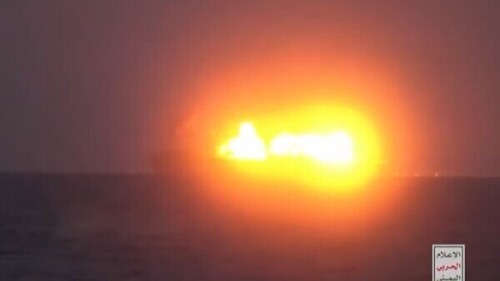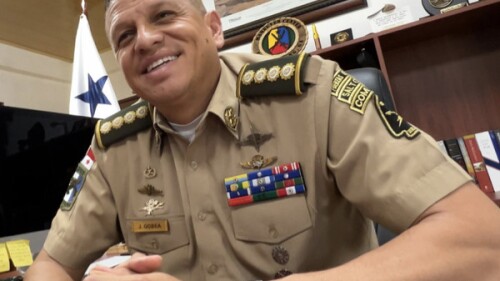Images from the deleted U.S. Customs and Border Protection press release. |
Amid a gathering mass-migration crisis on the southern border came a U.S. Customs and Border Protection (CBP) announcement April 5 that two Yemeni nationals who illegally crossed from Mexico into California were already on the FBI’s terrorism watch list before their arrivals. The agency removed the statement within 24 hours with no explanation, but too late:
One of the Yemenis, it said, also was on the FBI’s rarified No Fly list, normally reserved for individuals that U.S. intelligence deems highly dangerous, and had secreted a cell phone sim card in his shoe insole. The press release gave few further details, as an FBI Joint Terrorism Task Force investigation continues. But the nation’s Chief Border Patrol Agent seemed to understand the import.
“Part of the Border Patrol’s mission states we will protect the country from terrorists,” Chief Patrol Agent Gregory K. Bovino said in a prepared statement for the press release. “Today, like every other day, our agents did that.”
CPB said the release “was not properly reviewed and contained certain disclosure and policy information related to national security that required CBP to remove it from our website.”
Mainstream media and Democrats claim that terrorist border crossings do not really happen.
Absent much more context and better information, this short-lived official confirmation seems likely only to confuse an American public that has heard media fact-checkers and Democratic lawmakers for years assert that terrorist border crossings do not really happen. Indeed, the revoked press release landed even before the dust had settled from the latest such public argument over whether terrorist infiltration is a real threat; media organizations like the Washington Post carried stories last month ridiculing House Minority Leader Kevin McCarthy for relaying information about three Yemeni terror suspects and one Serb recently caught after illegal crossings into New Mexico. ...
So what can be truthfully said of this contentious threat issue? ...
U.S. Agencies Regard It as Real
Islamic extremists and those associated with terrorist organizations cross the U.S. southern border in consequential, though low numbers. Terror suspects like the Yemenis travel in an endless stream of some 3,000-4,000 migrants a year from Muslim-majority nations who get categorized in government nomenclature as “special interest aliens.” They are able to journey such great distances into Latin American landing and staging nations with the help of specialized global smuggling networks. Their total numbers may be comparatively small, but attacks by just a few portend vastly outsized national consequences. ...
U.S. homeland security professionals see the threat from special interest alien traffic as so consistently pressing, that they deployed counterterrorism programs at that southern border and throughout Latin America after 9/11. They have repeatedly detected terror suspects and, via deportation, neutralized any potential plots for years.
Abdulahi Hasan Sharif, a migrant who crossed the U.S. southern border, carried out an ISIS-inspired terror attack. |
The programs are divided between a “near war,” in which intelligence officers interview and investigate those caught at the border, and a “far war,” in which U.S. agencies partner with vetted local intelligence units throughout the Americas to hunt and destroy smuggling networks and capture jihadists en route. Most of those who are caught end up deported in what I term “better-safe-than-sorry” moves that few Americans ever hear about.
Democratic leaders have maintained the secret programs, one of the most recent proponents of them being Jeh Johnson, the DHS Secretary appointed by President Barack Obama. ...
Facts vs. Political Spin
Democrats and liberals interested in less or no border enforcement have invested tremendous energy over the years in disputing factual information about this threat. But the facts keep proving irrepressible.
Homeland Security Secretary Alejandro Mayorkas testifies (remotely) before the House Homeland Security Committee on March 17. He acknowledged that suspected Islamic terrorists have crossed the southern border. |
During a televised hearing on March 17, newly-confirmed Department of Homeland Security Secretary Alejandro Mayorkas confirmed the existence of a covert border war against jihadist border infiltration. ...
Mayorkas acknowledged that jihadist suspects were frequently caught by an “architecture, a multi-layered security apparatus” built to catch them.
“A known or suspected terrorist — KST is the acronym that we use — individuals who match that profile have tried to cross the border, the land border, have tried to travel by air into the United States, not only this year but last year, the year prior and so on and so forth,” Mayorkas testified. “And it is because of our multi-layered security apparatus, the architecture that we have built, since the commencement of the Department of Homeland Security, that we are in fact able to identify and apprehend them and ensure they do not remain in the United States. And so we actually deny them entry based on our intelligence and based on our vetting procedures, which have only grown in sophistication throughout the years.”
The deleted CBP press release and Mayorkas’s comments stand as inconvenient truths in contrast with relentlessly posted “fact-check” stories.
A mass-migration crisis threatens to overwhelm the “architecture” of America’s covert border war.
To date, the covert border war has done a remarkable job, even with developing cracks and problems in its “architecture.” The concern now is that a mass-migration crisis has developed that in the past has collapsed all normal systems. In extreme circumstances when high human volumes overwhelm security processes, all bets are off that the covert border war can function the way it must to catch more Yemenis on the terror watch list.
Todd Bensman is a fellow at the Middle East Forum and a senior national security fellow for the Center for Immigration Studies. He previously led counterterrorism-related intelligence efforts for the Texas Intelligence and Counterterrorism Division.










